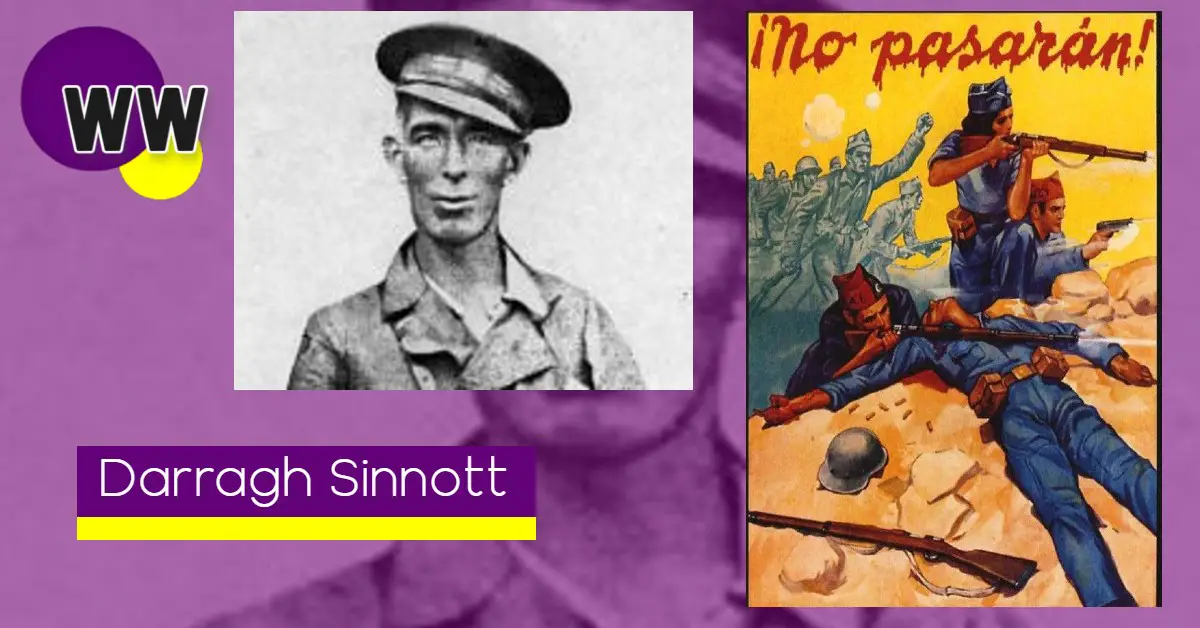Last Sunday various socialist and republican groups flocked to Monageer to commemorate and pay respect to a man fought in the War of Independence, the Irish Civil War and the Spanish Civil War…
A man who served as part of Na Fianna Éireann, the Irish Republican Army, the British Army and the International Brigades. Yet, despite all, this man is often overlooked not only on the national stage, but when considering the figures integral to the revolutionary period in Wexford. That man was Peter Daly.
Wexford roots:
Although Daly would go on to be associated with Wexford, he was not born in the model county, indeed he was not even born in Ireland.
Daly was born to a working class Irish family in Liverpool in 1903. His father, Lar Daly was a founding member of the Tom Clarke Society in Liverpool and was an active member of the radical republican group, the Irish Republican Brotherhood. No doubt a love of Ireland and a yearning for Irish sovereignty was instilled into Daly from a young age by his father who was by all accounts an avid Irish nationalist. The strong sense of community among the Liverpool Irish must’ve created a real sense of Liverpool being a home from home for Irish emigrants in the city. E
qually important to Daly in his political activism was his uncompromising socialist ideology, being of a working class family and having spent his formative years in a city with a thriving working class movement, no doubt the strength and solidarity within Liverpool’s working class must’ve left an impression on Daly. Therefore, we can see the ideologies of Republicanism and socialism which would come to define Daly’s life beginning to take shape due to the strong political influences in his early life.
Return to Wexford:
Daly and his family returned to Wexford in 1911 when Peter Daly was merely 8 years of age. They lived in Monageer where Peter attended the local national school. Under the encouragement of his father, Peter Daly joined Na Fianna Éireann, the Republican scouting organisation which had been founded by Bulmer Hobson and Countess Markievicz in 1909. The hard-line republican ideology which stood at the core of Na Fianna Éireann’s teaching left a lasting impression on Daly and along with the events of the Easter Rising and the War of Independence galvanised Daly as a hard-line republican.
Although he was too young to see serious action during the aforementioned War of Independence, he remained an active member of Na Fianna Èireann, organising anti British protests and running messages for the IRA. Daly is a prime example of the integral role played by those who may not have been on the frontline ambushing crown forces but played active roles on the organisational role of the campaign.
Civil War:
By the time the Anglo Irish Treaty was signed in December of 1921 Daly was 18 years of age and sided with the Anti Treaty side of the Civil War. The compromises made in the Treaty were intolerable to an ardent nationalist such as Daly and therefore he became an active member of the Anti-Treaty IRA. Daly engaged in the struggle against the Free State and National Army, during the bitter struggle in which old comrades turned their arms on one another Daly was wounded and taken prisoner. Daly spent 17 months imprisoned for his Republican activities in a Free State Gaol; he secured his release after an 18 day hunger strike.
Emigration to England:
The Irish Free State under Cumann na nGaedheal and WT Cosgrave found itself in a state of economic chaos and mass unemployment. Much of Ireland’s industry and infrastructure had been destroyed by the civil war and partition and as such many found it hard to find work. Many known members of the Anti-Treaty IRA found it difficult to find work following the civil war and many were black listed by employers. Due to this combination of economic hardship and his heavy association with the Republican cause, Daly along with others was forced to immigrate to England.
Daly took the ferry to Fishguard and made his way to London, sleeping in barns, fields and pig sties along the way. Daly worked various jobs before joining the British Army. His previous military experience in Na Fianna Éireann and the IRA meant that he rose quickly through the ranks of the British army and at the end of his service he has attained the rank of sergeant.
Some may have found it odd that the socialist republican had come to serve in the imperial army of occupation, the crown forces against which he had struggled, yet Daly’s loyalty to the Irish republic remained unwavering and for this he would be dishonourably discharged. It was discovered that Daly had been smuggling small arms to the IRA, this was a rather serious accusation which was tantamount to treason and as such Daly had to leave in a hurry.
Return to Ireland:
Daly remained active in the IRA and took up the position of training officer in the Wexford Brigade of the IRA. Although up to this point republicanism had been the predominant ideology of Daly’s life although socialism had always been a cornerstone of his political beliefs. Come 1934 it had become clear that the Fianna Fáil government under Eamon De Valera was beginning to renege on its republican ideology and the rhetoric of working class politics the republican movement became more and more fractured.
Daly joined other socialist republican such as Frank Ryan, Peadar O’Donnell and Michael O’Riordain in the Republican Congress. This group aimed to break both the power of the British state and capitalism in Ireland.
At first, the seemed a well organised force of republican socialists to be reckoned with although later divisions within the Congress arising with associations with the Communist Party of Ireland would vastly hinder its progress. Unemployment rates once more forced Daly to immigrate back to England in late 1934.
Background to the Spanish Civil War:
Socialism had saw a rise on the continent in post war Europe, socialist and centre left governments became far more commonplace. In Spain the socialists had come to form the government of the Second Spanish Republic, they had been democratically elected by the people of Spain in free and fair elections and thusly were rightfully viewed as the legitimate government of Spain. They had won an electoral mandate from the people and came to power in a peaceful manner.
Yet, the anti-clerical, anti-monarchist and socialist politics of the Republican and socialist popular front government did not sit well with the Spain’s wealthy citizens. General Francisco Franco launched a fascist coup d’état against the democratically elected government in 1936 which divided global opinion.
Ireland was equally divided on the matter socialists and republicans felt it was their duty to defend democracy in Spain and to attempt to stem the rising fascist tide which was sweeping Europe whereas the fascist militia the Blueshirts went to fight alongside General Franco (pictured right). Irish socialists and republicans felt obliged to fight alongside the second Spanish Republic on the basis of their principles of democracy and anti-fascism.
Daly answers the call:
At the time the Spanish Civil War broke out, Daly was living in London yet he heard rumours of an Irish brigade setting out to Spain under the name of the Connolly Column (named after executed leader of the 1916 rising James Connolly) to fight on the side of the Second Spanish Republic. Daly linked up with former comrades such as Frank Ryan (pictured) and Peadar O’Donnell in 1937 and travelled to Spain to contribute to the war effort.
Daly in Spain:
By this stage of his life, Daly held a great deal of military experience, he had participated in military drills and aided in military campaigns as a member of Na Fianna, he had seen action during the Irish Civil War, had been trained as a Sergeant in the British Army and had also trained others as training officer for the IRA in Wexford.
In other words, in an army which sorely lacked experienced combatants Daly was an experienced military man who would prove very capable on the field of battle and an asset to the Republican cause. He participated in many battles during the war in various areas of Spain including the Basque Country.
He was noted to his exceptional gallantry and showed notable grit and resilience to return to the front on two separate occasions having been injured. His experience, bravery and usefulness did not go unnoticed as Daly saw himself promoted to the rank of Captain. Daly was given command of the 15th International Brigade comprised of British and Irish soldiers. He led the Brigade into the Aragorn Offensive which would prove to be his last.
Death:
Hitler had sent battalions of battle hardened Nazi German troops as a part of the Condor Legions to aid fellow fascist Franco in Spain. Daly and his men faced a contingent of German and Spanish Francoist soldiers as they attempted to take Purburell Hill. Militarily speaking the objective seemed near impossible, Republican forces were attempting to attack heavily fortified fascist position attacking a better armed enemy up a hill. Yet Daly showed exceptional valance in leading the change up the hill. His outstanding gallantry would lead to his untimely demise.
Daly received a severe abdominal wound while carrying out the assault on Purburell Hill. Although against all the odds Republican forces took Purburell Hill, Daly succumbed to his wounds on . He does aged only 33 years of age and was buried Benicassim Cemetery near Valencia.
Commemoration and Legacy:
Daly was described by fellow IRA volunteer, Brigadista, republican and socialist Frank Ryan as “one of the finest comrades and bravest soldiers I have ever met and his death is a great blow, not only to our battalion but to the Irish republican and working-class movement”. Future leader of the Communist Party of Ireland Michael O’Riordain who served alongside Daly in the Republican Congress in the International Brigades described him as “a great Irishman and a great commander”. His military experience and Republican socialist fervour was near unrivalled.
A monument was erected to Daly in his former home of Monageer and “The Peter Daly Society” was formed for the purpose of keeping the story of Daly alive. For a man who played such a pivotal role in so many historic events it is a shame that Wexford has nearly forgotten one of its most gallant sons. Throughout his life Daly stood for Irish freedom, socialist politics and democracy consistently.
A monument stands in Daly’s home village of Monageer to commemorate his extraordinary life which was defined by a continuous struggle for freedom and for his class and his country. His life is not merely admirable but also a fascinating example of man who was involved many of the key events of a tumultuous period of Irish history. A man who fought for Ireland and democracy and who struggled against tyranny and fascism, Peter Daly remains no doubt one of Wexford’s most fascinating sons.
Sources:


